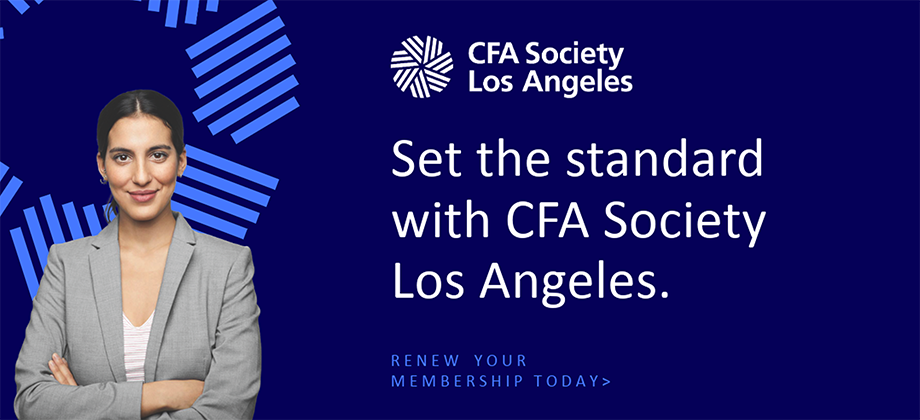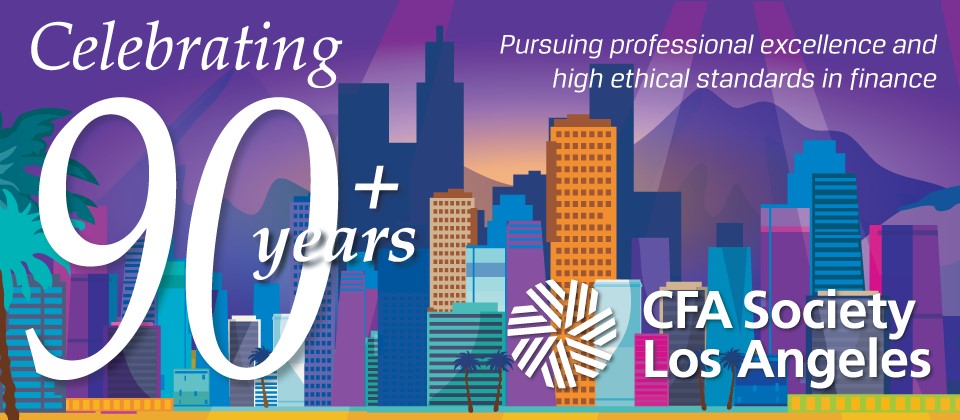February 2015
Welcome to the CFALA e-newsletter, a periodic publication with stories about noteworthy events and programs sponsored or hosted by the society, guest articles by members, book reviews, and other items of interest to CFALA members. Click on the headlines below to read the full stories. And if you’d like to contribute a story suggestion or, even better, write an article, we’d love to hear from you. Please email Executive Director Laura Carney at laura@cfala.org.
*Please note that the content of this e-newsletter should not be construed as investment advice, nor do the opinions expressed necessarily reflect the views of CFA Society Los Angeles.
In this issue ...
-
Turbulence Forecasted for Santa Monica Airport
-
Ethical Mindfulness
-
Edelman Trust Barometer 2015: Finance Services Industry Still Has Room for Improvement
-
29 Charts Worth Your Time
-
Central Banks Face Multiple Challenges in Trying to Stimulate Economic Growth Even With Lower Oil Prices, Analysts Tell CFALA 2015 Forecast Dinner Attendees
-
CFA Society Los Angeles YouTube Channel
Turbulence Forecasted for Santa Monica Airport
In a controversial, and some say illegal, move on the night of Sunday, March 30, 2003, Chicago mayor Richard Daley ordered a city crew to bulldoze giant X-shaped gouges in the runway surface of Meigs Field, an airport near downtown Chicago that Daley didn’t want anymore. The midnight city-sponsored vandalism was in violation of required notice to the Federal Aviation Administration. In the end, however, Daley won. The city paid a small fine, and Northerly Island, where Meigs Field used to lay, is now covered mostly with grass, and not an airplane in sight.
Opponents of Santa Monica Airport are looking for their Richard Daley.
Last November, an initiative in Santa Monica, the city-sponsored Measure LC, passed by an overwhelming margin. Measure LC amends the City Charter to prohibit new development on airport land unless approved by the voters, and affirms the City Council’s authority to manage the airport and to close all or part of it. Another measure – this one sponsored by airport advocates – was also on the ballot in November. Measure D required voter approval before the airport could be closed or redeveloped. Measure D failed. Considering the results of these two measures, it appears as though the City is in charge and the airport is in immediate danger of being closed. But like most issues dealing with competing interests and government agencies, there are complications.
Under a 1948 Instrument of Transfer, the Santa Monica Airport was given back to the City of Santa Monica by the U.S. government under the condition that it must be maintained as an airport “in perpetuity.” If this proviso was not complied with, the Federal government could take the airport back and run it. There was also a 1984 agreement between the FAA and the City having to do with the 5,000 foot runway, fuel sales and aviation tenants. That 1984 agreement expires in July, 2015.
So what do early-morning police escorted bulldozers and FAA “Instruments of Transfer” have to do with CFA Los Angeles? Santa Monica Municipal Airport (SMO) occupies 227 acres in the middle of the City. It is a significant economic engine, is home to 175 businesses and is responsible for 1,500 jobs and a reported quarter billion dollars in annual economic activity. Supporters of the airport, such as the Aircraft Owners and Pilots Association (AOPA), say closing the airport would be economically catastrophic, not to mention the cleanup expense if the airport is converted to houses, schools and business parks. In addition, if SMO were closed, additional air traffic would have to be absorbed by other regional airports such as Van Nuys, Zamperini (Torrance) and Camarillo. That is fine with the opponents of SMO.
On September 29, 2013 a Cessna Citation business jet crashed into a hanger at SMO. Although the crash killed only the plane occupants, airport opponents pointed to this accident as what is wrong with an airport that is surrounded by dense population. Namely, they believe the airport is dangerous to nearby residents and a menace to the city as a whole. Pollution, both noise and other, is reason enough to shut down SMO, they say.
Airport supporters fire back by noting the site was first used as a landing strip in 1919 and the Douglas Aircraft Company began testing its planes in Santa Monica in 1922. Complaining about an airport location that has been in the same spot since before World War II appears silly to many AOPA members. One AOPA member quipped that people who choose to live at the beach shouldn’t complain about the sand.
The City of Santa Monica city council has a history of enmity toward the airport, including a lawsuit filed in 2013 asking the court to give the city clear title to the airport land and disputing the claim that they are required to operate the airport in perpetuity. In the meantime, the city attempts to choke off the airport by imposing landing fees, curfews and other restrictions in an attempt to make the airport unattractive to pilots and business owners.
2015 will be a pivot point for the airport. The 1984 agreement expires which could lead to the city lopping off 2,000 feet of the runway which they claim is not part of the original 1948 agreement. If the airport is left with only a 3,000 foot runway, jet traffic will stop and many of the businesses which rely on executive travel will likely suffer a death blow. Fuel suppliers would likely fold up their tents. An airport with a 3,000 foot runway and no services would likely lose the control tower and the vast majority of its air traffic. Airport enemies could largely claim victory.
Like many land use issues, there are passions on each side. Federal government versus City government. Rich private jet owners versus rich land developers. Small business owners versus local homeowner. Airport opponents claim the airport is dangerous and no longer fits in the new city landscape. Besides, they claim, it is used almost exclusively by rich pilots flying million-dollar toys. Airport supporters say the opponents are NIMBYs who moved into an area near an airport that has been there since the 1920s, then have the temerity to complain about – gasp – airplanes.
Chicago Mayor Daley defended his “Meigs Massacre” by claiming it saved the City of Chicago further court battles in an effort to close Meigs Field. Daley said, “To do this any other way would have been needlessly contentious.” Airport supporters should probably be on the lookout for bulldozers in the vicinity of Santa Monica Airport.
Ethical Mindfulness
How do you stay true to your ethical bearings given the pressures to “produce,” bring in clients or generate fees?
This is a question many of us are struggling with. We don’t want to compromise our values. Yet at the same time, we have to earn a living, get along in the workplace and try to move up the corporate ladder.
There is a growing body of research on how and why ordinary people “cheat” by taking unfair advantage of others. Here are some examples and situations which may sound familiar.
· Environment. The incidence of cheating goes up when an experiment room is decorated with the trappings of wealth. It goes down if a poster of a watchful eye is posted nearby.
· Disclosure. Disturbingly, the tendency to take advantage of others goes up after disclosure. Presumably because the discloser feels more free to act in a self-serving way having given due warning to the client.
· Competition. People with passion, intensity, focus and loyalty are highly motivated and likely to succeed. But they are also more likely to unconsciously make ethical compromises in order to achieve that success.
· Slippery slope. Many ethical issues do not appear all at once but rather come into focus incrementally. Financial misreporting by public companies frequently begins with small acts of earnings management by overoptimistic managers.
· The team. Willingness to cheat goes up when the cheating also benefits others. This altruism is seen to justify the cheating. Commitment to an institution can override a commitment to good ethics.
· Tired or stressed. People cheat more when tired or stressed. Cheating can be contagious; evidence that someone in the room is cheating will lead to a greater number of others doing the same.
· Self-serving baseline. In a study by Max Bazerman and his co-authors at Harvard Business School, accounting students were asked to value a company. Some were told to represent the buyer, others the seller. The seller’s accountants valued the company 30% higher than the buyer’s accountants based on the same information.
In many cases we rationalize the abuse of a client’s trust as the normal way business is done. In other cases, we don’t even construe that we are confronting an ethical issue so that no conscious ethical deliberation ever happens. This is called ethical fading.
So what can we do to counteract ethical lapses and ethical fading?
Here are a few suggestions. Ask yourself if you would treat a close family member the same way you are treating your client. Ask yourself if you would be comfortable having the details of what you are doing publicized on the front page of a newspaper. Pay attention, care and be open to serious ethical reflection.
The society you want to live in depends on investment professionals like us being ethically mindful.
Send questions or comments to advocacy@cfala.org and find more information at the following link.
Edelman Trust Barometer 2015: Finance Services Industry Still Has Room for Improvement
The results of the 2015 Edelman Trust Barometer global study are out. Glenn Doggett, CFA, provides a summary of its most relevant findings in a CFA Institute Market Integrity Insights blog post. Read more... And more...
29 Charts Worth Your Time
In case you missed this one from CFA Institute's Enterprising Investor, here's an interesting collection of charts posted by William C.G. Ortel. Read more... And more...
Central Banks Face Multiple Challenges in Trying to Stimulate Economic Growth Even With Lower Oil Prices, Analysts Tell CFALA 2015 Forecast Dinner Attendees
In this press release covering our recent Annual Economic and Investments Forecast Dinner, CFA Society Los Angeles' Steve Fox highlights panelists' insights regarding the global economy in 2015. The press release has been featured in numerous online financial publications, including CNBC, MarketWatch, and Yahoo! Finance. Read more... And more...
CFA Society Los Angeles YouTube Channel
CFA Society Los Angeles established a YouTube channel in January. The channel is dedicated to providing interviews, educational programming, and other content relevant to investment professionals. It even includes a recording of our recent Distinguished Speakers event, "Fireside Chat with Dan Fuss." Read more... And more...








